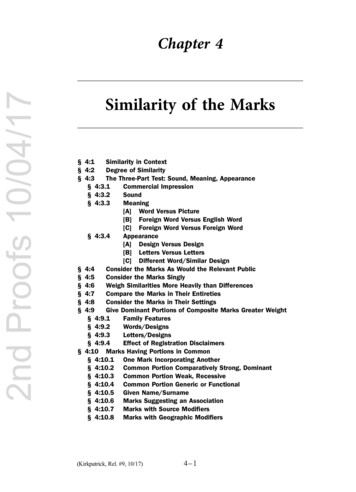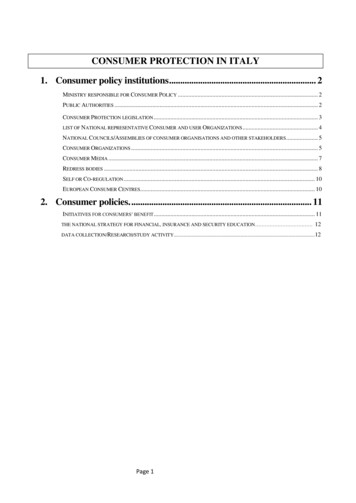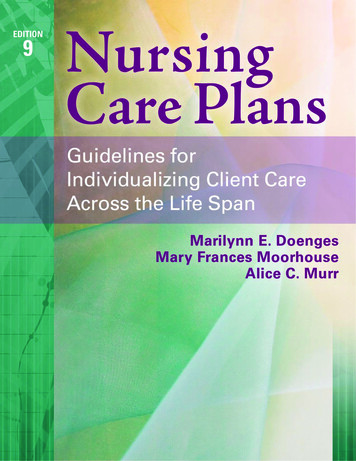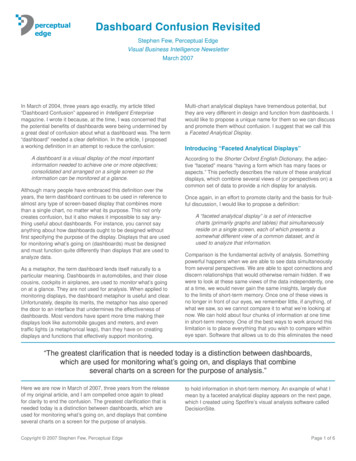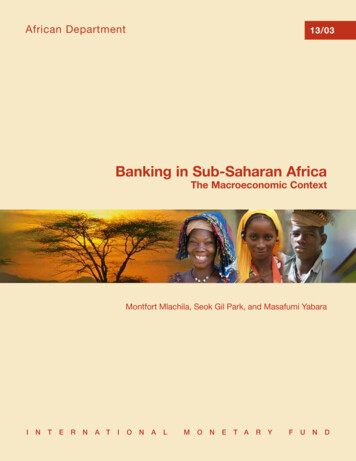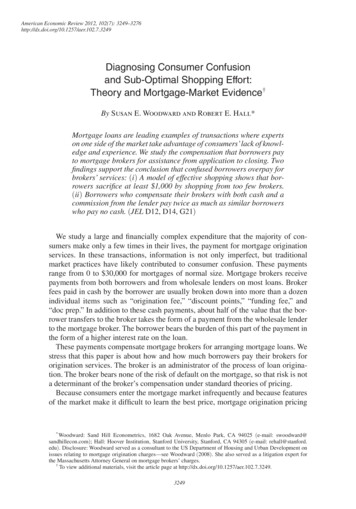
Transcription
American Economic Review 2012, 102(7): 9Diagnosing Consumer Confusionand Sub-Optimal Shopping Effort:Theory and Mortgage-Market Evidence†By Susan E. Woodward and Robert E. Hall*Mortgage loans are leading examples of transactions where expertson one side of the market take advantage of consumers’ lack of knowledge and experience. We study the compensation that borrowers payto mortgage brokers for assistance from application to closing. Twofindings support the conclusion that confused borrowers overpay forbrokers’ services: (i ) A model of effective shopping shows that borrowers sacrifice at least 1,000 by shopping from too few brokers.(ii ) Borrowers who compensate their brokers with both cash and acommission from the lender pay twice as much as similar borrowerswho pay no cash. (JEL D12, D14, G21)We study a large and financially complex expenditure that the majority of consumers make only a few times in their lives, the payment for mortgage originationservices. In these transactions, information is not only imperfect, but traditionalmarket practices have likely contributed to consumer confusion. These paymentsrange from 0 to 30,000 for mortgages of normal size. Mortgage brokers receivepayments from both borrowers and from wholesale lenders on most loans. Brokerfees paid in cash by the borrower are usually broken down into more than a dozenindividual items such as “origination fee,” “discount points,” “funding fee,” and“doc prep.” In addition to these cash payments, about half of the value that the borrower transfers to the broker takes the form of a payment from the wholesale lenderto the mortgage broker. The borrower bears the burden of this part of the payment inthe form of a higher interest rate on the loan.These payments compensate mortgage brokers for arranging mortgage loans. Westress that this paper is about how and how much borrowers pay their brokers fororigination services. The broker is an administrator of the process of loan origination. The broker bears none of the risk of default on the mortgage, so that risk is nota determinant of the broker’s compensation under standard theories of pricing.Because consumers enter the mortgage market infrequently and because featuresof the market make it difficult to learn the best price, mortgage origination pricing*Woodward: Sand Hill Econometrics, 1682 Oak Avenue, Menlo Park, CA 94025 (e-mail: swoodward@sandhillecon.com); Hall: Hoover Institution, Stanford University, Stanford, CA 94305 (e-mail: rehall@stanford.edu). Disclosure: Woodward served as a consultant to the US Department of Housing and Urban Development onissues relating to mortgage origination charges—see Woodward (2008). She also served as a litigation expert forthe Massachusetts Attorney General on mortgage brokers’ charges.†To view additional materials, visit the article page at http://dx.doi.org/10.1257/aer.102.7.3249.3249
3250THE AMERICAN ECONOMIC REVIEWDecember 2012is a market where one suspects that many consumers pay well above the best price.Our results confirm this suspicion.We reach our conclusion by studying the distribution of origination charges for alarge sample of mortgages involving brokers, where federally mandated disclosuresreport the entire amount of the broker’s revenue, showing both the cash chargesto the borrower plus the additional amount the lender pays the broker. We consider a minimal shopping strategy that borrowers might pursue in trying to findthe best price—getting quotes from two brokers, asking the one with the higherproposed price to beat the lower price of the opponent, and continuing this processuntil one broker is unwilling to improve on the other’s best proposal. This process isan English auction, in which the lower-cost broker gets the business and the chargeequals the cost of the losing broker, according to standard auction principles.It’s a standard statistical exercise to find the distribution of a variable from the distribution of the larger of a pair of draws from the variable. We perform that exerciseto calculate the distribution of broker cost. We find that the implied cost is generallyquite high, but more important, the upper tail of the cost distribution is thick—a significant fraction of mortgages appear to cost the broker more than 5,000 tooriginate. When we repeat the exercise for shopping among three and four brokers,we find that the implied distribution of cost is most implausible, with an even largerfraction implied to cost more than 5,000. The distribution has an implausible shapeas well. We conclude that among our shopping models, only the one where borrowers shop from just a pair of brokers is close to reasonable. Our conclusion thatborrowers consider no more than two mortgages draws support from surveys ofborrower behavior as well.Given this conclusion, we ask what benefit a borrower who shopped from onlytwo brokers passed up by not shopping from three or four. The answers are so largethat we believe that most borrowers must have been unaware of the likely benefitsof more shopping. For example, for a mortgage with 100,000 principal, a borrowerwould save a median of 981 by adding one more broker to the mix and 1,393by adding two. And with 200,000 principal, the savings are 1,866 and 2,664.Because we do not believe that borrowers would intentionally pass up such largebenefits just to avoid talking to another broker, we conclude that confusion abouthow this market works caused borrowers to shop too little. We doubt that borrowersunderstand either the nature of the payments made by wholesale lenders to brokersand their implications for the rate-cash trade-off, or the incentives these paymentspresent to the mortgage broker.Our second approach to studying confusion among mortgage borrowers is tocompare (i) the total origination charges for loans where the borrower pays a higherinterest rate to fund the origination charge to (ii) the total charges for loans wherethe borrower pays all of those charges in cash. The first group pays somewhat lowertotal charges than the second, but the important finding is that both those groups payfar less than borrowers who use both types of funding in roughly equal proportion.This evidence is consistent with the hypothesis that borrowers treat the two chargesindependently, failing to recognize that a borrower who pays more cash is entitledto a lower interest rate and vice versa.Earlier research has shown that mortgage charges are higher for less-educatedborrowers, members of minorities, borrowers who pay high interest rates, and
VOL. 102 NO. 7Woodward and Hall: Consumer Confusion about Mortgages3251those who borrow larger principal amounts—we review that research in the onlineAppendix. We confirm these findings. The research has not shown whether the borrowers paying higher charges did so because arranging the mortgage broker’s costwas higher or because those borrowers suffered exploitation due to their lack ofknowledge of the best available charge, which should be little higher than cost. Ourresults suggest that large fractions of the higher charges are the result of limitedshopping rather than higher cost.Our data come from a sample of mortgages insured by the Federal HousingAdministration (FHA) during a six-week period in 2001. FHA insures mortgages offairly creditworthy borrowers for modestly priced houses, up to loan limits that varyby geography. The borrower pays FHA an insurance premium. All of these loans are30-year fixed-rate mortgages for the purchase of a house. No loans have prepaymentpenalties. FHA bears essentially all of the default risk, so pricing of default risk isnot a concern for wholesale lenders and mortgage brokers.Our econometric approach is mainly non-parametric. We represent the full distribution of origination charges in terms of 299 quantiles, conditional on observedborrower and loan characteristics. From the quantiles, we make calculations of thedistribution of broker cost and of the charges that borrowers would have paid undermore effective shopping strategies. We provide bootstrap standard errors for all ofour calculations.I. Economics of Mortgage OriginationA mortgage is a loan secured by a house. The typical mortgage provides formonthly payments over a term of 30 years. The amount of the loan, called theloan principal, passes to the seller of the house at the moment when the borrowertakes ownership of the house, a moment called the loan closing. The borrower’s coupon rate is applied to the principal amount of the loan to calculate the borrower’smonthly payment. The loans are fully amortizing, so there is no final repayment ofprincipal, in contrast to the typical bond. The borrower has the option to pay off amortgage before 30 years, subject to a pre-payment penalty, which is limited by lawin all states. Because borrowers sometimes move, change houses, extract appreciated equity, and take advantage of lower interest rates to refinance, most mortgagespre-pay prior to their 30-year maturity. Nonetheless, roughly 30 percent of owneroccupied homes have no mortgage, and nearly all got to this state by paying off a30-year loan—see US Census Department (2001). Our FHA sample contains only30-year fixed-rate mortgages; there are no investor loans and no refinancings amongthem and none has a prepayment penalty.A. Brokers and the Yield-Spread PremiumMortgage brokers perform the service of originating a mortgage. A brokermatches a borrower with a wholesale lender. The broker is not a party to the resultingfinancial contract between borrower and lender and thus bears none of the defaultrisk of the mortgage. The broker helps the borrower prepare an application andarranges for the services of an appraiser and an agent to close the transaction. Thebroker serves lenders by finding potential borrowers and helping them complete the
3252THE AMERICAN ECONOMIC REVIEWDecember 2012n ecessary paperwork. Most large lenders have retail origination operations and alsouse brokers as originating agents. A broker usually has relationships with a numberof wholesale lenders.The borrower deals with a broker under conditions comparable to a purchaserdealing with a retailer of an expensive item. Like the retailer and purchaser, the broker and borrower negotiate the terms of the transaction without participation fromthe upstream wholesaler. The wholesaler provides funds for the loan under quotedterms. The borrower receives a specified amount of cash, the principal amount ofthe mortgage, delivered by the lender at the time of the closing, in exchange for amortgage at an interest rate resulting from the negotiation. The borrower also usually pays the broker a negotiated amount of cash at the closing; we call this the cashorigination charge. Berndt, Hollifield, and Sandås (2010) discuss the bargainingproblem between borrower and broker in the framework of the Nash bargain in itsalternating offer form.The broker may also receive a payment from the lender called the yield-spreadpremium or YSP, which is typically about half of the broker’s compensation. Theterms offered by the wholesale lender appear in a rate sheet, a document the brokerreceives from the lender at least daily. The rate sheet shows the YSP the lender offersto pay the broker for originating a mortgage. The YSP is an increasing function ofthe coupon rate and principal amount of the loan, and decreasing in the number ofdays (15, 30, 45, or 60) for which the loan is locked (the time the broker and borrower have to complete the loan). Because lenders can sell loans with higher ratesfor higher prices, the YSP rises as the rate on the loan rises, but at a decreasing ratebecause higher rate loans are likely to prepay sooner than lower rate loans, so higherrates are generally earned for shorter periods. This function is determined by expectations about movements in interest rates in the competitive wholesale mortgagemarket. We take it as given.The following example, representative of the transactions in our data, illustrates the operation of the YSP: A borrower pays her broker 1,800 as a cashclosing payment. In addition, the lender pays the broker a YSP of 2,300. Thebroker’s all-in cost, mainly the value of his time, is 2,400. The borrower haspaid 1,800 2,300 4,100 in origination charges for a loan when she couldhave pressed the broker to do the loan for close to 2,400. A savvy borrower couldhave insisted that the broker charge her only 100 in cash, which, together with theyield-spread premium of 2,300, would have just covered his cost of 2,400.Figure 1 shows an example of an actual rate sheet. The figures show the amountthat the lender will deliver at closing on behalf of the borrower (always taken to be100) plus the premium to be paid to the broker, such as 2.25 percent of the principalfor a loan at a coupon rate of 8.875 percent with a lock period of 30 days. Notice thatbelow the solid line, the YSP becomes negative. For loans at these low interest rates,the borrower (not the broker) pays the specified amount of cash into the closing tomake up the difference.The coupon rate that corresponds to a zero YSP is called the par rate and is a useful benchmark rate. It corresponds to the row in the figure just below the solid line.A recent change in mortgage law bars lenders from making payments to origination agents (loan officers and mortgage brokers) that are tied to the interest rate onthe loan. The new rule attempts to ban both payments of YSPs to mortgage brokers,
VOL. 102 NO. 7Woodward and Hall: Consumer Confusion about Mortgages3253Lock periodRate15 days30 days45 days60 00099.50099.87599.375Figure 1. An Actual Rate Sheet for April 2000who were required to disclose YSPs, and to agents of correspondent lenders, who,under the law prevailing in 2001, were not required to report YSPs. The ban hasno effect on the underlying logic that a borrower faces two ways to compensate alender for origination services, by paying cash up front or accepting a higher interestrate. It imposes no limit on the interest rate that a lender can charge. Vertically integrated lenders have never faced any requirement to disclose the internal equivalentof a YSP or any limit on its amount. The evidence in this paper based on observedYSPs is directly relevant to the structure the new law created. The new law changesthe organization of mortgage origination in a way that obscures the YSP withoutchanging the economic forces that cause lenders to charge borrowers for originationservices in part through higher interest rates.B. Bargaining over Mortgage TermsThe YSP lets the home-buyer borrow funds to compensate the broker, providedthe borrower remains within the lender’s payment-to-income limits at the higherinterest rate and corresponding higher payment. The value flowing from the borrower to the broker is the cash origination charges plus the YSP. For the broker,the mix of the two components is immaterial, as the broker receives both the cashorigination charge and the YSP as cash at the same time. For a borrower who is cashconstrained and knows she is likely to pay off the mortgage fairly soon, the cost ofthe higher interest is less than what the broker receives as YSP, so their efficient bargain should pay the broker entirely with the YSP and the origination charge shouldbe zero (or even negative, which occurs in a small fraction of our sample). Similarly,for a borrower expecting to have the loan for a long time, the cost of the higher rateis greater than the YSP and then the efficient deal with the broker will not involveborrowing any of the broker’s compensation; rather, the borrower will pay it in cash,and even pay a negative YSP to lower the interest rate further. The online Appendixcontains a formal model of the bargain between broker and borrower.C. Potential Consumer ConfusionOur predictions about the efficient deal between borrower and broker rest onthe assumption that the borrower is able to recognize when she is paying a higher interest rate and thus creating value that could be used to pay the broker in place of
3254THE AMERICAN ECONOMIC REVIEWDecember 2012a cash origination charge. Another possibility is that some borrowers are unable tospot when an interest rate is high enough to deserve a reduction in the cash chargesand thus wind up paying both normal cash charges and giving the brokers handsomeYSPs as well. A profit-maximizing broker will try to keep borrowers uninformedabout the availability of mortgages at lower interest rates, in the hope of earninghigh compensation from both components.The borrower’s understanding of the mortgage market is often incomplete. Formortgages on newly purchased homes, the buyer’s real-estate broker often refersthe purchaser to a mortgage broker, who explains that he has access to mortgagesfrom dozens of competing lenders and that he can help the borrower choose theone with the best terms. The mortgage broker does not mention that each of theselenders links the interest rate to the YSP that the broker will receive. He proposesone or more mortgages, each with a rate that includes as big a YSP as he thinks theborrower will accept. His proposal includes a rate and detailed cash originationcharges. His offer will reflect how careful and informed a shopper he believes theborrower is.Mortgage law in effect at the time of our sample required the broker to providethe borrower at this stage in the process a good-faith estimate of the originationcharge, but not of the YSP. Thus the borrower did not know prior to making a dealwith a mortgage broker how much the broker will earn in total fees. The borrowermight have eventually learned the amount of the YSP, in principle, because the lawrequired its disclosure at the time of the closing, on the HUD-1 form that is part ofthe closing document package. The terminology of the disclosure, the location of theYSP entry on the form, and the bewildering nature of the form itself likely inhibitedmany borrowers from understanding the YSP. In any case, the information arrivedlong after the mortgage deal was made.D. PointsOne important source of confusion among borrowers is the labeling of parts ofcash origination charges as “points.” A great deal of commentary on mortgage economics shares this confusion. A point is a component of the broker’s originationcharge calculated as a percent of the principal amount of the loan. From the perspective of the economics of a mortgage origination, a charge for points is just part of thetotal amount that the borrower pays to the broker. Borrowers may believe that paying points “buys down” the interest rate. In principle, this should be true. If a brokerreceives part of his cash origination charge as points, just as in any other form, theborrower should be able to bargain for a lower interest rate and thus a lower YSP.But this only happens if the borrower uses the added bargaining power that payingmore cash to the broker ought to give the borrower. Nothing stops the broker fromoffering an interest rate that earns him a handsome YSP and also including a chargefor points as part of the pricing of the origination. In our sample, charges for pointson loans are present on roughly 30 percent of the loans with positive YSPs.When the coupon rate is sufficiently low that the YSP is negative, the borrowerwill face a charge for points that are paid to the lender. If the charge for points is theamount on the rate sheet for the negative YSP (below the horizontal line in Figure 1),the charge genuinely brings a lower interest rate. But here too, the broker may charge
VOL. 102 NO. 7Woodward and Hall: Consumer Confusion about Mortgages3255more for points than the lender receives—nothing stops the broker from chargingmore for the negative YSP than appears on the rate sheet and keeping the excess aspart of his own compensation. In any case, negative YSPs are rare in our sample,despite the high frequency of charges labeled as points.Even the borrower’s understanding of the broker’s cash fees may be limited bythe practice of dividing the charge into many elements. Figure 2 is an examplecontaining terms found frequently in our data. The good-faith disclosure formprevailing when these loans were written did not require brokers to state the sumof the charges (new rules do require disclosure of the sum), so comparison ofloans was challenging. Some of the challenge remains, because the disclosurelaw perversely allows for points to be separated from other origination charges,suggesting that even the regulators fail to understand that points are just anothername for broker or lender charges. Borrowers may not recognize that only thesum—including points—is meaningful. Lacko and Pappalardo (2007) found thatfew borrowers had any idea what the term “discount points” means, and worse,that one-third believed it was a discount they were receiving instead of an amountthey were paying.E. Industrial Organization Analysis of Mortgage BrokerageOur findings later in the paper suggest that an important fraction of borrowersleave a lot of money on the table for their brokers. As we show later in the paper, theupper tail of the distribution of origination charges brokers receive contains someastonishingly large values. We use the term margin to mean the difference betweenthe revenue from originating a mortgage and the cost of executing the transaction.Here we include only costs incurred after the broker meets the borrower and strikesa deal. The margin is the amount at issue when the broker bargains with the borrower over the charge. Thus we believe that mortgage brokers earn substantial margins from many but not all of their origination efforts.Mortgage brokerage involves only small out-of-pocket costs for the broker. Amortgage broker does not usually outsource any of the origination process to otherprofessionals. Further, though charges labeled “origination fee,” “funding fee,”and “commitment fee” sound as if they passed through to the lender, they remainfirmly in the broker’s pocket. Thus the costs we have in mind are largely the valueof the broker’s time.The equilibrium we describe is inefficient. We do not believe that mortgage brokers earn any important rents from their origination activities. Entry to mortgage brokerage is close to free. Most states license mortgage brokers or require them to havelicenses as real-estate agents, but these licenses are not difficult to obtain. Mortgagebrokers dissipate the anticipated margin from confused borrowers by spending effortand other resources trying to find these customers. Because borrowers seldom seekout several brokers to compete for the borrower’s business, brokers have to workhard to find brokerage customers. In Lacko and Pappalardo (2007), the modal number of loans considered by borrowers was two. In Federal Reserve Board (2009),more than half of all borrowers looked seriously at only one loan.We noted earlier that mortgage brokers often receive referrals from real-estatebrokers and that it appears that many borrowers accept a proposal from such a
3256THE AMERICAN ECONOMIC REVIEWDecember 2012Borrower signs up for 8.875% with a 60-day close, 100,000 loanLender delivers 100,000 on behalf of borrowerBroker getsFrom lender: 2,300From borrower: 800755020015025200300 4,100yield-spread premium (paid outside of closing)origination feewarehouse wire feefee for preparing amortization table for loandocument processing chargefunding feefax feedocument review feecommitment feeTOTALFigure 2. Example of a Loan Transaction ortgage broker without further shopping. Hence the referrals are valuable andmmortgage brokers cultivate real-estate brokers hoping to receive their referrals.Federal law—the Real Estate Settlement Practices Act—prohibits mortgage brokersfrom paying referral fees, but little is known about the effectiveness or enforcementof that prohibition. In any case, we believe that a zero-profit equilibrium prevails inthe mortgage-brokerage business, where new entrants expect a zero net payoff giventhe costs of finding customers. But once found, some of the customers are veryprofitable. From the social point of view, the resources dissipated by brokers in theirsearch for overpaying customers are wasted.II. Data and Data Description ModelA. Description of the FHA dataTable 1 describes the variables in our analysis. We excluded loans with ratesbelow 7 percent and those with interest rates not at 0.125 point ticks as presumptively subsidized. Interest rates are fairly tightly clustered around 7.5 percent, asshown in the first column of Table 2. All the loans were made at essentially thesame time, so the variation arises in the cross section of borrowers and not fromchanges in credit markets. The total origination charges— cash origination chargeplus yield-spread premium—average 4,111, but have substantial dispersion. Thecash component is typically a little under half of the total charge and the YSP a little more than half. The principal is generally around 100,000 and rarely exceeds 200,000. The average credit score of the borrower is 659, which is just below themedian of the national distribution of scores. The fractions of the borrowers whoare members of minorities are close to the US average in the population, at 11percent African American and 14 percent Latino. The last statistic is the fractionof the adult population in the borrower’s census tract who hold a BA degree—itsaverage level is 21 percent. We have no measure of the education of individualborrowers, but are able to measure the education of their neighbors because weknow the addresses of the borrowers.
VOL. 102 NO. 7Woodward and Hall: Consumer Confusion about Mortgages3257Table 1—Descriptive Statistics for Brokered LoansTotal closing charge, dollarsPercent of closing cost paid in cashPrincipal, dollarsCredit scorePercent African AmericanPercent LatinoPercent of neighbors with BA degreesNumber of 916312Table 2—Average Yield-Spread Premiums in the FHA Data, by Interest RatePercent ofsampleAveragerate incategory, percentAverage yield-spreadpremiumper 100 principalSD ofYSP ratio7 to 7.3757.57.625 to 7.8753739137.177.507.781.332.322.680.600.590.838 and higher118.113.181.13Interest rate incategory, percentB. The Yield-Spread PremiumThe YSP is a payment from the wholesale lender to the broker based on the coupon rate for the mortgage and on the amount of the principal. The lender pays thepremium to the broker outside the closing. Earlier we reviewed what we believeis highly reliable evidence about the formula for the YSP from rate sheets. Herewe examine the information in the FHA data on the YSP, which provides a different view of the formula. The source of the FHA broker compensation data is theHUD-1 settlement statement, required by the Real Estate Settlement Practices Act(RESPA). This source is potentially imperfect, because there seems to be relativelylittle monitoring of the accuracy of a broker’s disclosure and the broker may try toconceal a large premium from a borrower. Table 2 shows the average yield-spreadpremium for the brokered loans in our sample, by interest rate.Figure 3 compares the relation between the coupon rate and the YSP in the FHAloans and in the rate sheets we discussed earlier. We adjusted the coupon rate fromthe rate sheets downward by 99 basis points to account for the general decline inrates between 2000 and 2001, as reported by the Federal Reserve Board. The errorbars are the standard errors of the average in each category (hardly visible forthe FHA data because of the large number of observations). The slope of the premium is generally lower in the FHA data. The difference in the slope could reflectchanges in expectations about pre-payments and changes in the slope of the yieldcurve between 2000 and 2001. It could also reflect some tendency for brokers tounderstate their actual premiums when they are high. Because the yield-spreadpremiums reported in the FHA data are not obviously at odds with those in therate sheets, and because we are unable to adjust the curve from 2000 apart fromshifting it to the left, we accept the reported premiums for the rest of our analysis.
3258December 2012THE AMERICAN ECONOMIC REVIEW9–5–FHA data, 20013–1––1 ––3 ––––––––5 –6.0–Rate sheets, 2000–Yield-spread premium, dollars per hundreddollars principal7–6.57.07.58.08.59.09.5Interest rateFigure 3. Comparison of Yield-Spread Premiums in FHA Loansand Lenders’ Rate SheetsC. Descriptive ModelA broker receives revenue(1)τ L Y(r)from originating a mortgage at coupon rate r. In Section IB, we noted that brokersare surely unconcerned about the mix between the cash from the borrower, L, andthe cash from the lender, Y(r), and that the typical borrower should be close toindifferent about the mix as well. The near-indifference suggests we should start bystudying the sum.All earlier research on mortgage terms has examined the expectation of τ or itscomponents conditional on a vector of observed characteristics, via regression. Ourinterest extends to the entire distribution of τ conditional on characteristics, a vastlymore complicated object than the expectation. Our approach is to estimate the quantiles τ i (x) of the distribution as functions of the observed characteristics x. The quantile gives the value of τ such that the probability that τ is no greater than τ i (x) hasa designated value, q i . It is the inverse of the cumulative distribution function F(τ):(2)F( τi (x)) q i ,where q i is the designated probability for quantile i. We take the probability valuesto be: q i i/300 for i 1, , 299. W
to mortgage brokers for assistance from application to closing. Two findings support the conclusion that confused borrowers overpay for brokers' services: )(A model of effective shopping shows that bori - rowers sacrifice at least 1,000 by shopping from too few brokers. (ii) Borrowers who compensate their brokers with both cash and a

